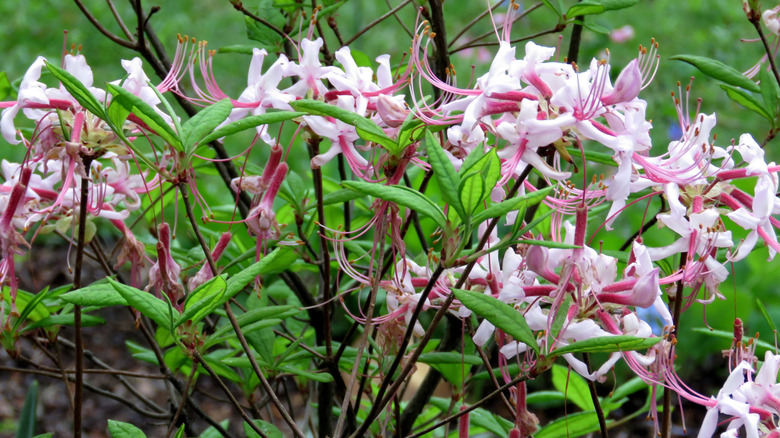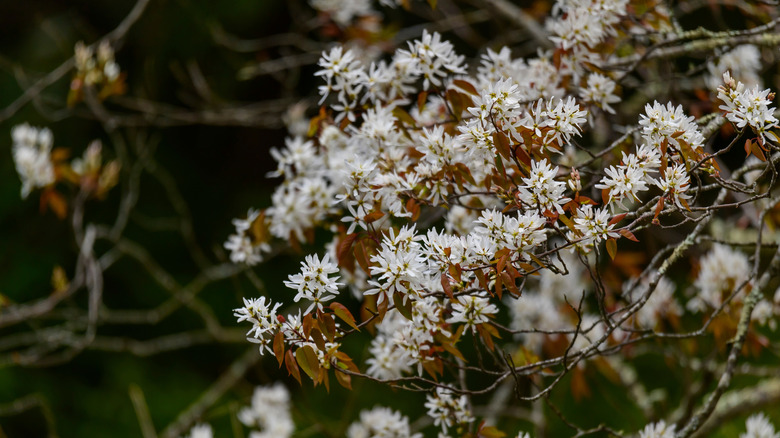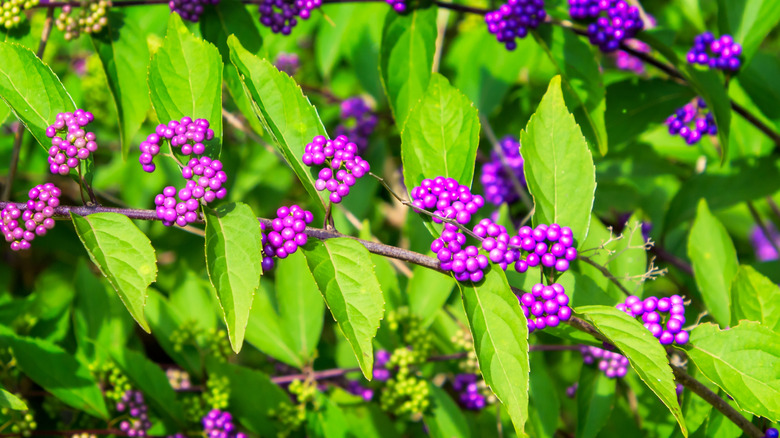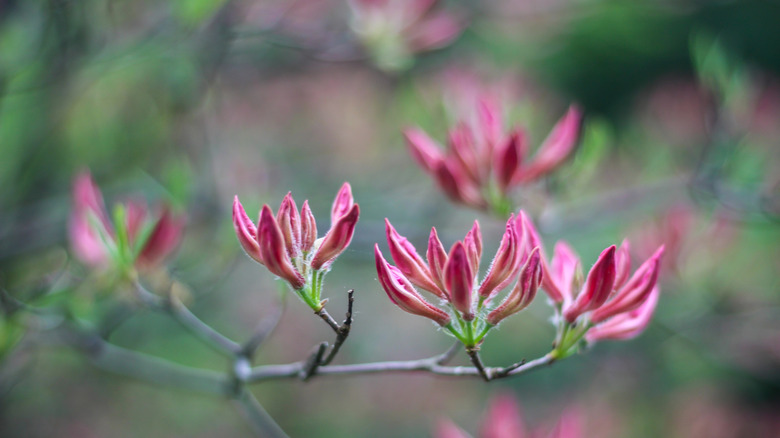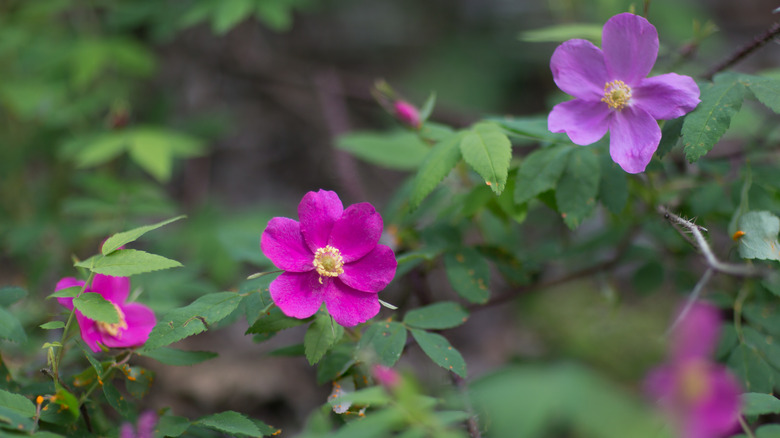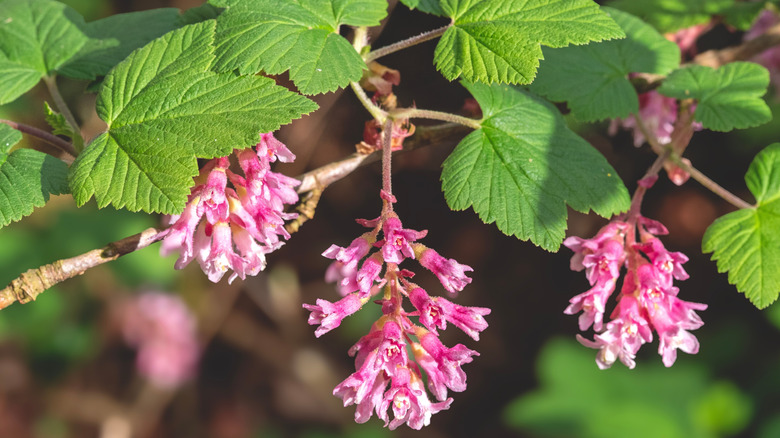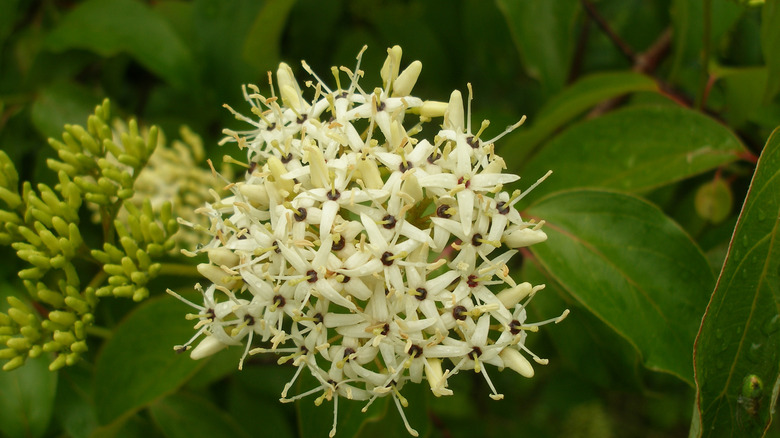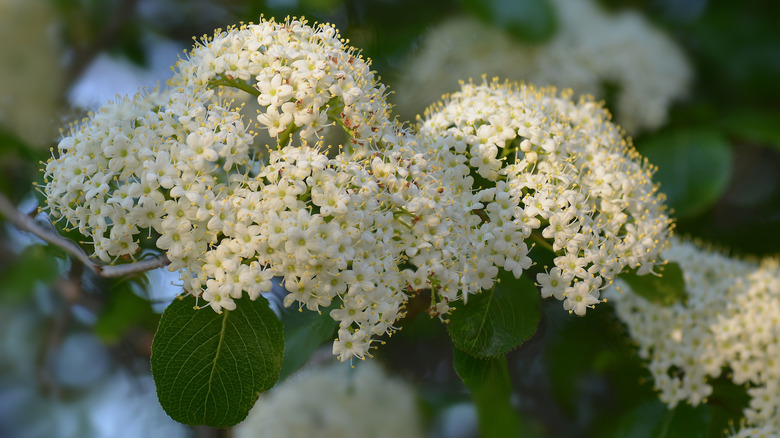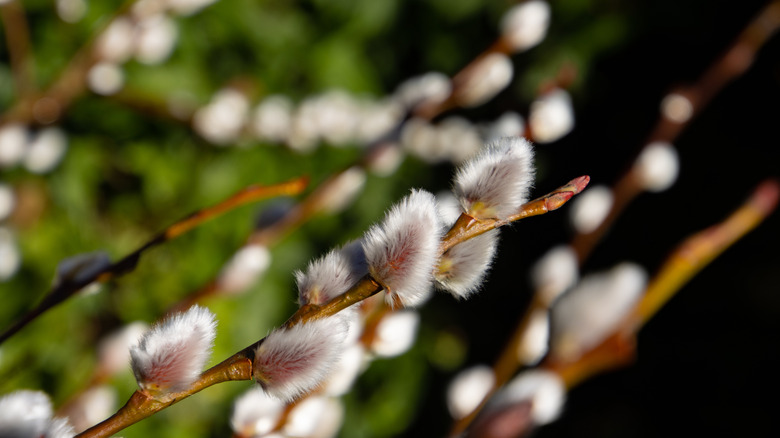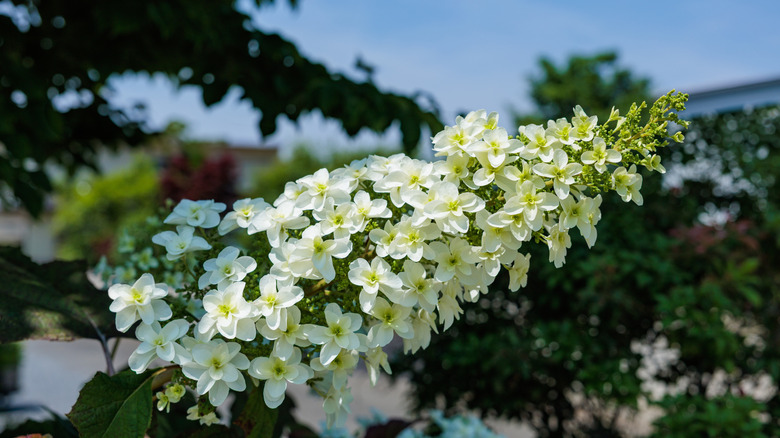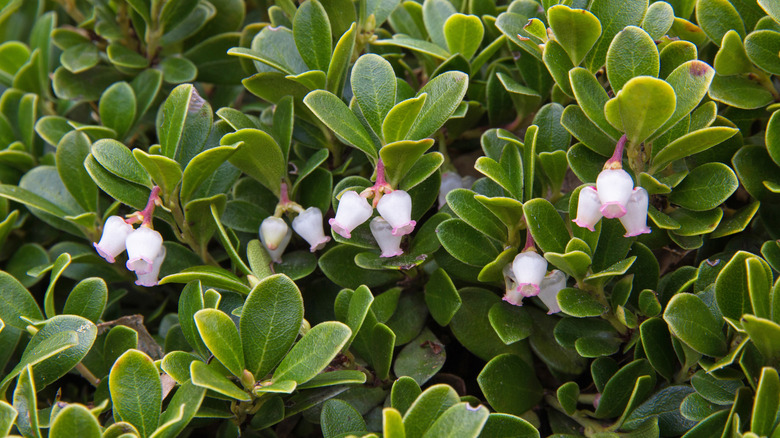16 Gorgeous Shrubs To Plant In November For Stunning Spring Color
November is an excellent time of year to plant shrubs. While your annuals and tender perennials may have bitten the dust after the first frost of the season, it's not too late to get ready for spring by planting certain shrubs. Unless you live in the coldest parts of the United States, the ground likely has not frozen over and is still viable for planting. Southern areas may not freeze until much later in the season, if at all. Suitable shrubs, like downy serviceberry, bearberry, and others in our lineup below, will establish their roots in the fall then produce stunning spring blooms that make your November efforts worth it.
Native shrubs stand the best chance of overwintering well and rewarding you with spring beauty. They have adapted to North American climates long before humans even arrived here. The flowers they produce in spring will attract native pollinators hungry after a long winter's fast. Those flowers often turn into summer fruits that support local wildlife as well. Fall will bring a variety of leaf colors, and the seeds that follow the fruits can provide winter sustenance to wild animals as well. That's year-round enjoyment for you and the creatures that share your garden.
Downy serviceberry
There are a number of species in the Amelanchier genus, but downy serviceberry (Amelanchier arborea) is one of the prettiest, producing a flush of fragrant white flowers in early spring, to the delight of pollinators. Its fruit is edible, providing nourishment to songbirds and small mammals. Downy serviceberry is hardy in USDA Hardiness Zones 4 through 9. Plant it in full sun to part shade in neutral or slightly acidic soil that gets good drainage.
American beautyberry
American beautyberry (Callicarpa americana) deserves its name not just for the beautiful spring flowers it provides but for the gorgeous fruit that can last throughout the growing season — unless the local birds and mammals get to it first. In late spring, American beautyberry produces clusters of white, pink, or cream-colored flowers on long, arching stems. By summer, those flowers develop into purple or bluish berries that can feed wildlife into early winter. American beautyberry is hardy in zones 6 through 10. It grows best in full sun to partial shade in a wide variety of well-draining soils.
Chokeberry
Despite its unattractive name, chokeberry (Aronia arbutifolia) can be an appealing addition to your garden. Spring will bring an abundance of white to light pink flowers, which in turn summon bees and butterflies in search of nectar and pollen. In late summer, clusters of red berries appear, providing food for songbirds all the way into winter. As chokeberry looks best in mass plantings, plant a number of them in full sun to part shade in soils of any pH, as long as it gets good drainage. Chokeberry is hardy in zones 3 to 9.
Mapleleaf viburnum
In late spring, mapleleaf viburnum (Viburnum acerifolium) reveals delicate clusters of tiny white flowers, which attract butterflies. If you want those flowers to turn to berry-like drupes for the birds to enjoy, you'll need to plant more than one viburnum variety for cross-pollination. Hardy in zones 4 to 8, mapleleaf viburnum can tolerate more shade than other viburnum species. Plant it in dappled light or partial shade in moist, acidic soil with good drainage. It can grow into dense thickets, so it makes a good privacy hedge.
Northern spicebush
Hardy in zones 4 to 9, northern spicebush (Lindera benzoin) produces fragrant yellow flowers in early spring before its leaves appear. Each individual flower is small, but their abundance puts on quite a show. The flowers are then replaced by edible bright red drupes. In fall, the leaves turn yellow. Northern spicebush fares well in full sun to full shade in acidic to neutral soil that's moist but well-drained. The shrub naturalizes well, so give it some space to fill in.
Pinxterbloom azalea
Of the many species of rhododendrons and azaleas, pinxterbloom azaleas (Rhododendron periclymenoides) have to be among the most attractive of spring bloomers. In May, the plant produces a profusion of pink or white funnel-shaped flowers with a subtle fragrance. Plant it in rich, moist, well-draining, acidic soil. It can withstand direct sun in cooler climates, but it does best in part shade and is hardy in zones 4 to 9. Its downside is that all parts of the plant contain poison that can be toxic to animals if ingested in large quantities.
Nootka rose
If you like multiflora roses but want to avoid the invasive garden threat they pose, opt for Nootka roses (Rosa nutkana) instead. Nootka roses are a wild native plant common to western North America, with fragrant, deep pink pollinator-friendly blossoms arriving in spring. The fruits are attractive to wildlife as well. Nootka rose is hardy in zones 5 to 9. It may take some pruning to keep your Nootka rose in place, but it makes an excellent thicket or hedge. Plant it in full sun to part shade in a nearly any type of soil, as long as it's moist and well-draining.
Red flowering currant
If you want an abundance of early spring blossoms, plant red flowering currant (Ribes sanguineum). The shrub will be covered with gorgeous clusters of drooping pink and red flowers. By fall, those flowers will turn into edible berries that provide food for birds and small mammals. Red flowering currant is hardy only in zones 6 to 8 and doesn't do well in highly humid environments, like southern United States. For best results, give it full sun to part shade. It's not picky about soil types, as long the medium is moist but well-draining.
Silky dogwood
Unlike its tree relatives, silky dogwood (Cornus amomum) is a multi-stemmed shrub that grows up to 12 feet tall. It produces clusters of small, pollinator-friendly, cream-colored flowers in spring, which turn into blue fruits favored by birds. Hardy in zones 5 to 8, silky dogwood is found naturally alongside wetlands, ponds, and waterways, so it prefers moist or wet soil that's slightly acidic. Silky dogwood will do well in all levels of light, from deep shade to full sun.
Swamp honeysuckle
Swamp honeysuckle (Rhododendron viscosum) is not actually a honeysuckle — it's in the Rhododendron genus — but you might understand the confusion if you see its cluster of white flowers, inviting hummingbirds and bees to lap up its nectar. Its fragrant flowers open up in May and last until July. Hardy in zones 3 to 9, it requires full sun to part shade in well-draining soil that is slightly acidic and rich in organic matter.
Arrowwood viburnum
Another viburnum to bring delight to your garden is arrowwood viburnum (Viburnum dentatum). In spring, it produces creamy-white flowers favored by pollinators, followed by blue-black berries that might be mistaken for concord grapes. The fruit is edible, but you can also just leave it for the birds. Arrowwood viburnum can grow to 10 feet tall and wide, so give it plenty of room. In zones 2 to 8, plant it in full sun to part shade in neutral or slightly acidic soil that is moist but well-draining.
Blackhaw viburnum
Blackhaw viburnum (Viburnum prunifolium) is another native viburnum that blooms in mid to late spring with large white flower clusters. Pollinators flock to its nectar, while birds and wildlife will enjoy the blue-black berries that follow. This easy-to-grow shrub appreciates full sun or part shade and average soil of any pH, as long as it drains well. It's hardy in zones 3 to 9.
Pussy willow
Pussy willow (Salix discolor) is a one-of-a-kind spring treat. Its fuzzy, gray catkins appear in early spring before any leaves arrive, then open into yellowish white flowers, great for bees and other pollinators just emerging from their long winter's nap. Pussy willow is hardy in zones 2 to 7 and spreads easily, with roots that can clog sewers or drains and crowd out competing plants, so keep it away from your house. Plant it in full sun to part shade in moist, well-draining soil, and prune it back to keep it under control.
Lewis' mock orange
Note the "mock" in Lewis' mock orange (Philadelphus lewisii). It's not a real orange tree, nor is it even a tree. But its spring and early summer blossoms emit a sweet orange-like fragrance that can cover the shrub and attract butterflies. It can grow up to 12 feet tall, so if you're planning to place it in a front yard, give it room as a back-of-the border shrub. In zones 4 to 9, plant it in full to partial sun in moist, well-draining soil of any acidity. Blossoms appear on old wood.
Oakleaf hydrangea
Oakleaf hydrangea (Hydrangea quercifolia) hails from southeastern United States. Producing foot-long clusters of white, showy flowers in late spring to midsummer, oakleaf hydrangea can spread up to 8 feet tall and 10 feet wide. It makes a beautiful privacy hedge with four-season interest, as its leaves turn orange and red in fall. It's hardy in zones 5 to 9 and grows best in rich, moist, well-draining soil in full sun to part shade.
Bearberry
Bearberry (Arctostaphylos uva-ursi) is a low-growing shrub that graces a garden with white or red heart- or bell-shaped in mid-to-late spring sprinkled among its green glossy leaves. It's easy to grow but doesn't like being transplanted. Hardy in zones 2 to 6, it thrives in cooler climates, attracts hummingbirds and butterflies, and makes an excellent ground cover. Its fruits are edible, though bland. Plant it in full sun to part shade in acidic, well-draining soil.
